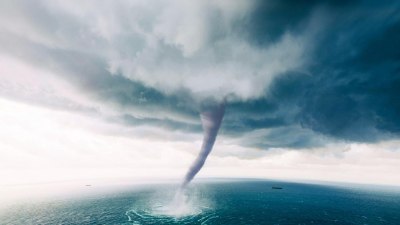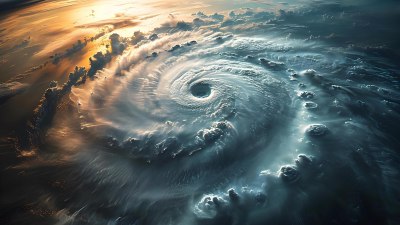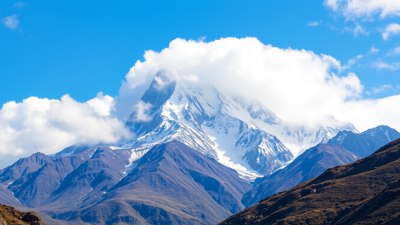Why Do Some Clouds Look Like a Blanket
Explore the fascinating reasons behind clouds that appear like a soft, cozy blanket.

This image was created with the assistance of Freepik
Clouds are one of nature's most captivating phenomena, serving as a crucial component of the Earth's atmosphere. Among the various types of clouds, some exhibit a distinctive appearance reminiscent of a soft, cozy blanket draped across the sky. In this article, we will delve into the science behind these blanket-like clouds, exploring their formation, characteristics, and the meteorological conditions that lead to their presence.
The Basics of Cloud Formation
To understand why some clouds resemble a blanket, it is essential first to grasp the basic principles of cloud formation. Clouds form when warm air rises into the atmosphere, expands, and cools. As the air cools, the water vapor it contains condenses into tiny water droplets or ice crystals, depending on the temperature. These droplets or crystals cluster together to form clouds. The specific appearance of clouds, including whether they look like a blanket, depends on several factors.
Types of Clouds
Clouds are categorized into various types based on their appearance and altitude. The primary classifications are stratus, cumulus, cirrus, and nimbus clouds. Of these types, stratus clouds are often the ones that appear like a blanket. Stratus clouds form in horizontal layers, covering the sky in a uniform, gray layer.
Unlike cumulus clouds, which are fluffy and heaped, stratus clouds present a flat, smooth appearance that can envelop the sky. This layered structure can obscure the sun, leading to overcast conditions. These clouds often bring light rain or drizzle, contributing to their association with dreary weather.
Characteristics of Blanket-Like Clouds
One of the most recognizable types of blanket-like clouds is the stratus cloud. Stratus clouds typically form at lower altitudes, generally below 6,500 feet (2,000 meters). Their uniform color and texture, grayish appearance, and extensive coverage of the sky give them a blanket-like quality.
Another cloud type that may appear blanket-like is the altostratus cloud. These clouds occur at mid-level altitudes, between 6,500 and 23,000 feet (2,000 and 7,000 meters). Unlike stratus clouds, altostratus clouds can exhibit a blue or gray hue, and they often precede precipitation from storms.
Meteorological Conditions Favoring Blanket Clouds
Various meteorological conditions promote the formation of blanket-like clouds. One common scenario occurs when warm, moist air rises over cooler air masses. This scenario often happens during stable atmospheric conditions, where there is little vertical movement of air, allowing moisture to spread out and form layers.
Temperature inversions, which occur when a layer of warmer air traps cooler air below it, can also lead to the development of blanket-like clouds. Under these conditions, stratus clouds can form, creating a consistent layer that resembles a blanket across the horizon.
Additionally, frontal systems, such as warm fronts, contribute to the formation of stratus clouds. As a warm front moves into an area, warmer, moist air lifts over cooler air, resulting in the development of extensive cloud layers.
Seasonal Variations
The appearance of blanket-like clouds can vary with the seasons. During fall and winter, stratus clouds are more prevalent due to cooler temperatures and increased moisture. These clouds can create a homogenous gray sky, often described as gloomy.
In contrast, during the warmer months, the development of stratus clouds may decrease as rising temperatures lead to more unstable atmospheric conditions and an increase in cumulus clouds. Cumulus clouds, characterized by their fluffy and towering shapes, are less likely to resemble a blanket than their stratus counterparts.
The Role of Fog
Fog is another atmospheric phenomenon closely related to the appearance of blanket-like clouds. It occurs when the air near the ground cools and becomes saturated with moisture, leading to the formation of tiny water droplets that hang in the air. This can create a thick layer of fog that resembles a cloud blanket resting on the ground.
Just as blanket-like clouds cover the sky, fog acts as a blanket that envelops the Earth’s surface. Both phenomena share similar processes of condensation and cooling, contributing to their comparable appearances.
Cloud Observations and Weather Predictions
Cloud patterns and types provide valuable information for meteorologists in making weather predictions. The presence of blanket-like clouds, such as stratus, can indicate an overcast sky and the likelihood of precipitation. By understanding how these clouds form and behave, weather experts can offer more accurate forecasts and warnings.
Cloud observation is vital not only for meteorology but also for various sectors such as agriculture, aviation, and outdoor activities. A thorough understanding of cloud types enables farmers to manage their crops, pilots to navigate changing conditions, and outdoor enthusiasts to plan their activities accordingly.
In summary, some clouds look like a blanket due to specific atmospheric conditions, cloud types, and formation processes. Stratus clouds, in particular, exhibit a layered structure that gives them a smooth and flat appearance akin to a cozy blanket draped across the sky. Understanding these cloud formations enhances our appreciation of weather phenomena and complements knowledge in meteorology and environmental science. So, the next time you gaze at the sky and spot a blanket-like cloud, you'll have a deeper insight into the fascinating world of clouds and the science behind their captivating shapes.











